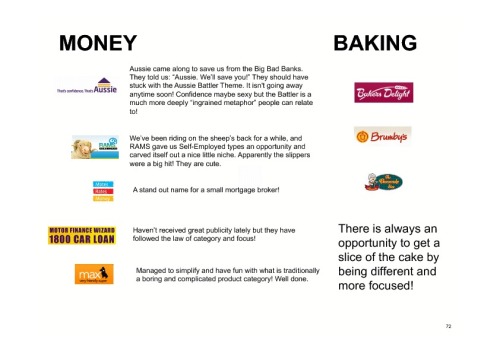
by admin | Feb 19, 2011 | Blog, Content, Design, Promotion, Strategy
A Brand Positioning Statement, also known as a slogan or a strap line, is the creative interpretation of the Brand Promise or USP which we discussed earlier.
Brand (Positioning Statements) should be able to hold their position in the long run and ideally achieve the following 4 criteria:
- Differentiate the business (Communicate the USP)
- Provide a Creative (Campaignable and Sustainable) platform
- Benefits should be ideally expressed explicitly to the customer
- Provide support to the brand name
Even when designing a brand from scratch it is difficult to satisfy all 4 criteria, so meeting 3 for a new brand or even 2 during a re-brand is often a great result.
You need to communicate with:
- Clarity
- Consistency
- Compression
to ‘cut through’ the clutter that is now prevalent in most service and product categories to consumers who are bombarded by more commercial messages than ever before!
So how do we do this?
Firstly we need to “own “own” a place in the consumer mind.
the easiest and most effective way of “owning a place in your customers’ and prospects’ minds is to focus on the things that matter. Most small and medium enterprises do not have the time or the money to be all things to all people, in fact neither do the very big companies, and when they try, they end up meaning nothing to anybody.
The result is at best mediocrity.
Focus demands Sacrifice – To own something you need to give up something else.
Focus on the particular type of buyer. Markets consist of buyers who differ in their:
- Wants
- Resources
- Locations
- Buying attitudes
- Buying behaviours
Simplicity adds value, by adding a halo effect for other benefits:
- Simple benefit (the most important promise) oriented word works best no matter how complex the product or market.
- The word must be exclusive.
- Avoid change, personalities don’t change, neither should your Brand.
- Positioning takes years and people don’t really change.
Next we will illustrate the power of brand positioning and focus with some examples.
How 2 Players Effectively communicated their Brand Positioning

Here are 2 industries and examples how the different players have through focus have found their niche and then effectively communicated their brand positioning.
Examples of the segmentation and brand positioning in the car…
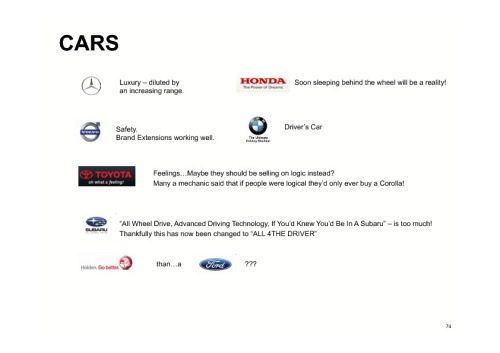
Examples of the segmentation and brand positioning in the car industry.
Positioning examples through segmentation in the car insurance…
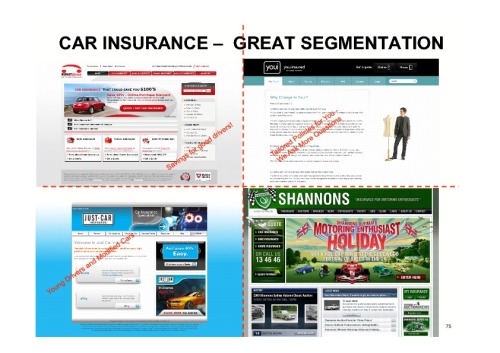
Positioning examples through segmentation in the car insurance category.
Most of the builders don’t have a positioning statement…
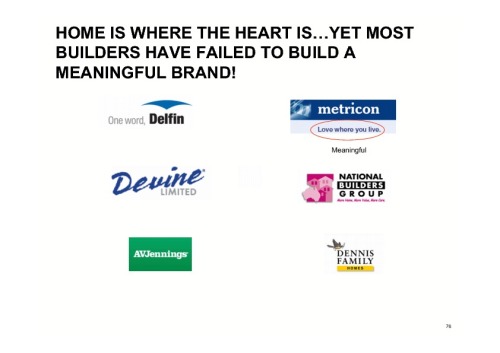
Most of the builders don’t have a positioning statement and are missing out on a great opportunity to truly connect with their prospects as well as be able to develop creative and more effective communication.
There is always an opportunity to be the “first”…
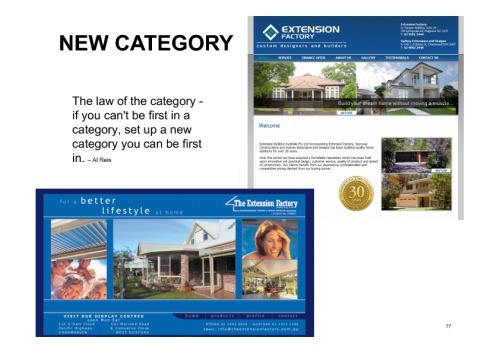
There is always an opportunity to be the “first” through even more focus. At the same time one has to be careful to protect their brand name!
…and then you can focus some more!
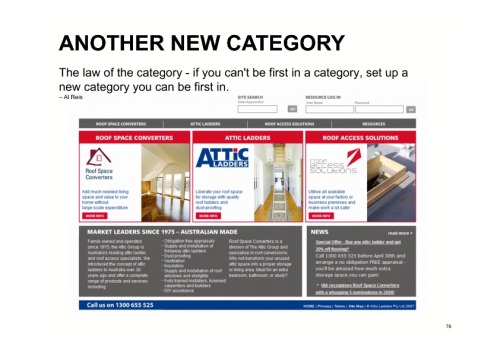
…and then you can focus some more!

by admin | Feb 17, 2011 | Blog, Strategy
Why are today’s smart marketers talking about Brand Promise rather than the all too familiar USP – Unique Selling Proposition?
The answer is simple. The low barriers to entry in most industries created by the free and almost instant flow of information, resulting in the hyper-competitive nature of today’s marketplace means there are very few unique products and services and if they are unique to begin with they do not stay so for very long.
This paradigm shift has repercussions for for every modern enterprise. It means that brand owners and marketers must create unique experiences for their customers and communicate them clearly to their prospects. Because these experiences are what will differentiate them from their competitors. To do so they must work out what it is that they can promise their customers.
Product, Price, and Place (distribution) can be easily copied by competitors, which is why marketers invest much time and budget into Promotion (Communication). What can not be copied is the relationship, the emotional connections you develop with your customers. And like all relationships, they require consistent and clear communication.
Brand Promise must be:
- A Benefit that is relevant and important to the target market.
- A benefit that is different from the competitors.
- A benefit that your company is able to deliver.
The benefit may be:
- Functional
- Emotional
- Experiential
- Self-Expressive
Brand Promise is ideally expressed as:
Only (name of your brand) delivers (relevant differentiated benefit) to (target customer).
The Brand Promise is a critical ingredient that assists marketers work out the Positioning Statement.

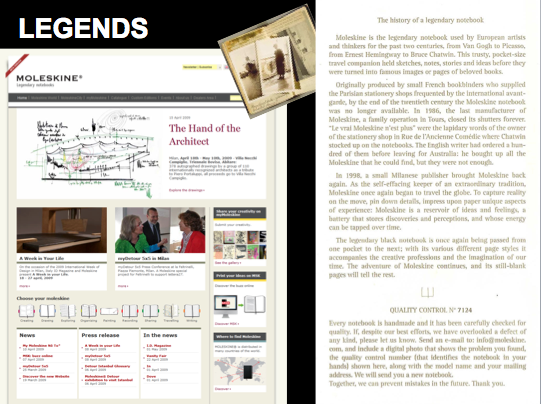
by admin | Feb 16, 2011 | Blog

You can buy a notebook at your local newsagent or office supplies store for $2-$4, but a large enough number of people in the creative industries choose to pay up to 10 times that for the legendary Moleskin.

by admin | Feb 16, 2011 | Blog, Design
“Most people can agree on what Santa Clause looks like – jolly, with a red suit and a white beard. But he did not always look that way, and Coca-Cola advertising actually helped shape this modern-day image of Santa.
2006 marked the 75th anniversary of the famous Coca-Cola Santa Clause. Starting in 1931, magazine ads for Coca-Cola featured St. nick as a kind, jolly man in a red suit. Because magazines were as widely viewed, and because the image of Santa appeared for more than three decades, the image of Santa most people have today is largely based on our advertising… Before the 1931 introduction of the Coca-Cola Santa Claus created by artist Haddon Sundbiom, the image of Santa ranged from big to small to fat to tall. Santa even appeared as an elf and looked a bit spooky…
The Cocacola Company began its christmas advertising in the 1920s with shopping-related ads in magazines like The Saturday Evening Post… At this time, many people thought of Coca-Cola as a drink only for warm weather. The Coca-Cola Company began a campaign to remind people that coca-Cola was a great choice in any month. This began with the 1922 slogan “Thrist Knows No Season”, and continued with a campaign connecting a true icon of winter – Santa Claus – with the beverage.”
Many of the older brands have rich histories that make them “legendary”, however new and small brands can benefit similarly if they follow the rules of being interesting and authentic. Keep in mind these “legends” were also just a small business, with nothing more than the vision and passion of their founders.
Did Coca Cola really invent Santa Claus? Maybe not but it certainly made him their brand ambassador and part of our popular culture for ever!

by admin | Feb 16, 2011 | Blog, Content, Promotion, Strategy

Cover via Amazon
People love stories from children’s fairy tales to books and movies. A story is more memorable than a straightforward message. A story is easy to re-tell and pass on to other consumers, hence providing your brand with more Word of Mouth Marketing opportunities.
A brand story needs to be:
- Real and authentic
- Colourful and interesting
Advertisements are nothing more than stories with the best ones engaging their audience. Famous brands such as Virgin and Apple have real stories surrounding their founders and form an important element of their positioning strategy.
Most common marketing stories:
Blake Snyder (professional screenwriter) has story scenarios that align to Maslow’s Hierarchy of needs:
- Physical Needs
- Safety Needs
- Social Needs (Buddy Love & Rights of Passage)
- Self Esteem Needs (Fool Triumphant & Superhero)
- Cognitive Needs (Everyman v Big Brother)
- Aesthetic Needs (Look good, Feel Good)
- Self Actualisation (Search for Meaning & Personal Salvation)
Gerald Zaltman, author of “How Customers Think” and Professor at Harvard Business School identifies deep metaphors in the minds of consumers in “Marketing Metaphoria”:
- Balance
- Transformation
- Journey
- Container
- Connection
- Resource
- Control
and Christopher Booker’s book, “Seven Basic Plots – Why We Tell Stories” (which took him 35 years to write) has the following:
- Overcoming the monster: Defeating a force which threatens safety, existence, success – David v Goliath
- The Quest: A group in search of something (who may find it or something ‘better’)
- Journey and Return: The hero journeys away from home and comes back (having experienced something and maybe having changed for the better)
- Comedy: Not necessarily ‘haha’ funny. a misunderstanding or ignorance is created that keeps parties apart, which is resolved, by the end, bringing them back together
- Tragedy: Someone, tempted (vanity, greed, etc), becomes increasingly desperate, or trapped by their actions, until the climax where they usually die
- Rebirth: Hero is captured or oppressed (a living death existence) until they are miraculously freed
- Rags to Riches: Overcoming a state of poverty, want, and/or need.
By telling your brand story you can differentiate your business and form a stronger connection with your customers and prospects. By understanding why you started the business, or for example why you named it in a certain way, customers will feel like they know you and understand you. After all it is hard to connect with someone you don’t understand.












Recent Comments